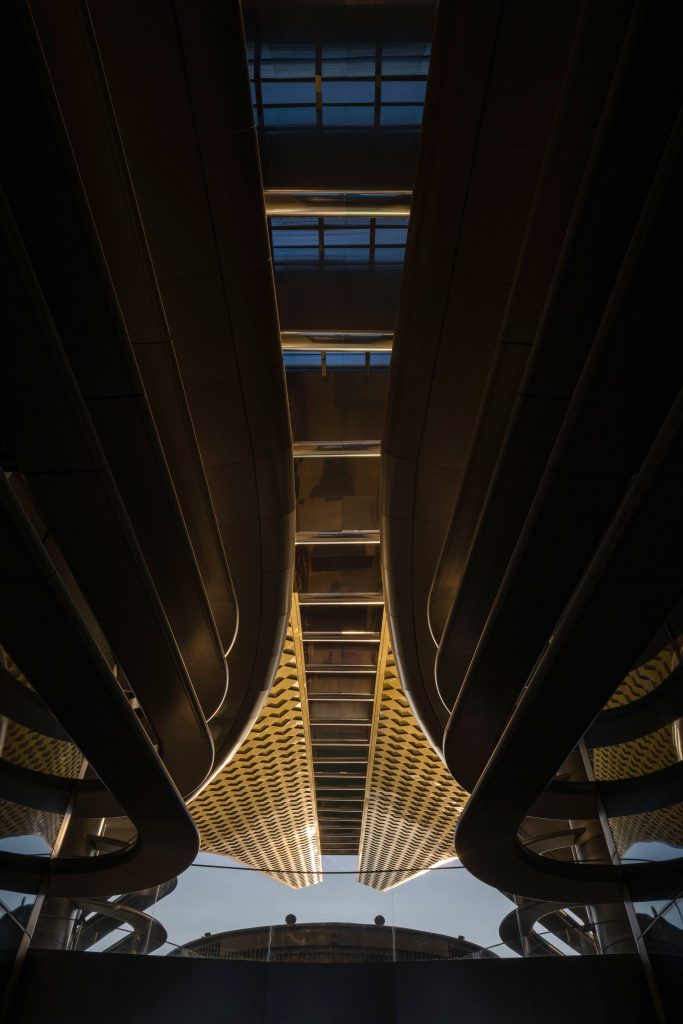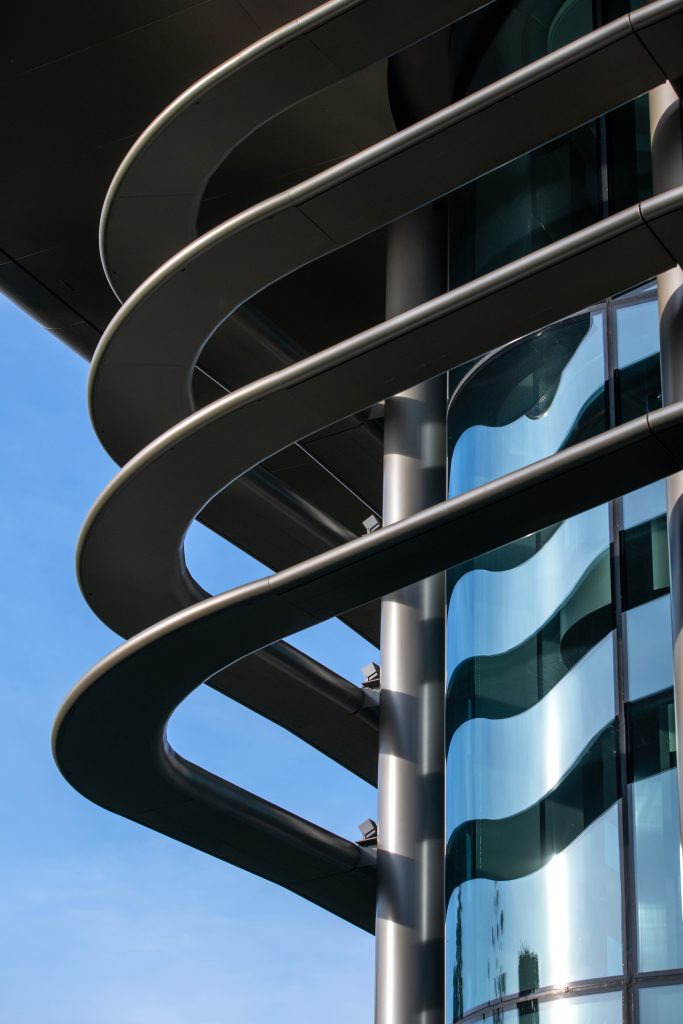Designed by F&P (Thailand), the Forest Pavilion is aesthetically unique with its distinctive 30-meter steel structure roof integrating the park’s activity zone into a single coherent space.
Text: Xaroj Phrawong
Photo Courtesy of F&P (Thailand) Company limited

จากการเปิดตัว Crystal Palace ในปี ค.ศ.1851 ออกแบบโดย Joseph Paxton ดูเป็นหมุดหมายที่ บ่งบอกถึงเรื่องราวของสถาปัตยกรรมได้ ทั้งในแง่ ภาพสะท้อนของยุคสมัยใหม่ และบ่งบอกถึงเวลา ของวัสดุสมัยใหม่อย่างเหล็ก และกระจก หลังจากนั้นโลกของสถาปัตยกรรมได้ค่อยๆ เปลี่ยนไป จากวัสดุแบบดั้งเดิมที่มีความหนาหนักได้พัฒนาสู่การใช้วัสดุที่เบาขึ้น แต่สามารถครอบคลุมพื้นที่ได้เท่ากัน หรือมากขึ้น ในประเทศไทยก็ใช้โครงสร้างเหล็กมากขึ้นตั้งแต่ยุคสมัยใหม่ จากคุณสมบัติที่สามารถก่อสร้างได้เร็ว ครอบคลุมพื้นที่ได้กว้าง ลดความเทอะทะเมื่อเทียบกับคอนกรีต
บนย่านเศรษฐกิจใหม่ชานเมือง อำเภอบางพลี จังหวัดสมุทรปราการ ส่วนที่ติดกับเขตบางนา กรุงเทพมหานคร ได้เกิดโครงการเมืองขนาดใหญ่ The Forestia ที่มีโปรแกรมเป็น Mixed-Use ผสมกันหลากหลายทั้ง ส่วนพักอาศัย พาณิชยกรรม โรงพยาบาล โรงแรม ในพื้นที่ใจกลางของ The Forestia มีอาคารส่วนกลาง ที่ทำหน้าที่ต้อนรับผู้มาเยือนคือ Forest Pavilion ออกแบบสถาปัตยกรรมโดย F&P (Thailand) Company Limited ตั้งอยู่ใจกลางสวนป่ารกครึ้ม ดูแตกต่างจากความวุ่นวายของถนนบางนา-ตราด ด้านหน้าอย่างสิ้นเชิง

สภาพแวดล้อมโดยรอบ Forest Pavilion เป็นการปลูกป่านิเวศ (Eco-Forest) ตามหลักทฤษฎีของศาสตราจารย์ อาคิระ มิยาวากิ ที่มีแนวคิดเน้นการฟื้นฟูระบบนิเวศป่าธรรมชาติด้วยการปลูกป่าเลียนแบบวิถีธรรมชาติ พืชที่เลือกมาใช้เป็นไม้พื้นเมืองหาได้ในท้องถิ่น ทำให้เกิดความหลากหลายทางชีวภาพ และฟื้นฟูพื้นที่ขึ้นมาในระยะเวลาน้อยกว่าแบบอื่นๆ 10 เท่า การแบ่งพื้นที่ใช้สอยออกแบบให้เป็น 2 ปีก ปีกทิศเหนือและทิศใต้ แบ่งออกด้วยทางเดินตรงกลาง ที่ปลายทางเดินเป็นห้องรูปทรงกระบอก ภายในบรรจุหุ่นจำลองของโครงการไว้ ปีกทิศเหนือและปีกทิศใต้ ในการใช้งานเฟสแรก จะเป็นพื้นที่ต้อนรับลูกค้าที่เข้ามาเยี่ยมชมโครงการ และตัวอย่างห้องแบบต่างๆ ในโครงการ ในการใช้งานเฟสที่ 2 จะมีการเปลี่ยนแปลงการใช้งานเป็นพื้นที่สำหรับนิทรรศการ พิพิธภัณฑ์วิทยาศาสตร์ ส่วนพื้นที่ห้องทรงกระบอกจะเปลี่ยนการใช้สอยจากห้องหุ่นจำลองกลายเป็นคาเฟ่ในที่สุด
การออกแบบพื้นที่ ได้ต้นแบบมาจากศาลาโถงหรือศาลาแบบไร้ผนัง ซึ่งเป็นภาษาสถาปัตยกรรมร่วมกันในอุษาคเนย์ บอกถึงพื้นที่ต้อนรับ การแยกพื้นที่เป็น 3 ก้อน ให้แยกจากกัน เกิดให้พัดผ่านทางเดินตรงกลางเป็นตรอกลมตลอดวัน พัดเอาอากาศที่มีอุณหภูมิไม่สูง จากการปรับพื้นที่ให้เป็นป่าในเมือง การแบ่งพื้นที่ใช้สอยเป็น 3 ชั้น การเดินใช้พื้นที่ทางเดินตรงกลาง สายตาถูกชักนำให้ไปจบยังห้องหุ่นจำลอง
จากการจัดวางองค์ประกอบแบบสมมาตรของอาคารทั้ง 2 ปีก พร้อมกับเส้นช่องแสงจากหลังคาที่ดูคล้ายเป็นการแยกหลังคาออกเป็น 2 ส่วน ยิ่งเพิ่มการนำสายตาไปยังปลายหลังคา โดยส่วนปลายอาคารเชิดขึ้นด้วยการยื่นหลังคาออกไป 30 เมตร เพื่อการเชื่อมโยงเข้ากับสวนป่าด้านหลัง การปรับระดับสายตาจากระนาบหลังคาเมื่อเดินใช้งานทุกส่วนจนผ่านปลายทางเดินแล้ว ระดับสายตาจะถูกชักจูงให้เห็นทัศนียภาพของสวนป่าในที่สุด

แนวคิดการออกแบบให้ประหยัดพลังงาน มีความยั่งยืน ดูเป็นสิ่งที่สถาปนิกนำเสนอเป็นประเด็นหลัก ทั้งเรื่องการระบายอากาศ สถาปนิกใช้การออกแบบองค์ประกอบทั้งพื้น ผนัง หลังคา ให้แยกชิ้น ทำให้เพิ่มพื้นที่รอบรูปอาคาร อำนวยให้เกิดลมพัดผ่านแต่ละส่วนได้มากขึ้น ประเด็นการดึงแสงธรรมชาติเข้ามาร่วมในการออกแบบได้มีการออกแบบหลังคาให้แยกออกเป็น 2 ชิ้น เพิ่มหลังคาโปร่งแสงตรงกลาง จากนั้นทำการลดแสงแดดที่นำพาทั้งความร้อน และแสงที่มากเกินการใช้สอยด้วยแผงสะท้อนแสงที่เพดาน แผงเหล่านี้ออกแบบเป็นลักษณะลิ่มสามเหลี่ยมเว้นให้แสงแดดผ่านแบบ indirect แสงแดดที่ส่องผ่านหลังคาจะกระทบกับผิวข้าง แล้วสะท้อนแบบกระจายแสงลงมาที่โถงทางเดินอีกที ให้แสงธรรมชาติลงมายังพื้นที่ทางเดินให้นุ่มนวลขึ้น
หลังคาที่คลุมส่วนของอาคารทั้ง 2 ปีก ถูกออกแบบให้มีการลดความร้อนจากหลังคาจากกรีนรูฟอีกทาง นอกจากการแยกการเพิ่มเส้นรอบรูปให้ลมพัดได้มากขึ้น บนหลังคายังติดตั้ง Solar Photovoltaic Cell เพื่อผลิตไฟฟ้าจากแสงอาทิตย์มาใช้ในโครงการ และยังมีการกักเก็บน้ำฝนมาใช้ในโครงการจากหลังคาอีกเช่นกัน หากมองเป็นภาพรวมหลังคาจะมีลักษณะเป็นกรวยหันปากกรวยไปยังทิศใต้ ที่ทำหน้าที่รับลมเข้ามายังภายในอาคาร โดยเฉพาะโถงทางเดินกลาง และยังมีการออกแบบรายละเอียดให้ฝ้าชายคามีลักษณะเป็นแผ่นลอนซิกแซก เพื่อลดความเร็วลม พร้อมกับจับลมในเวลาเดียวกัน
จุดน่าสนใจของงานนี้คือการใช้ระบบปรับอากาศที่ต้องการลดเสียงของเครื่องปรับอากาศ หากใช้ระบบปรับอากาศแบบทั่วไปจะมีเสียงจาก condensing unit ดัง และปล่อยความร้อนรบกวนผู้อยู่อาศัยได้ วิธีการแก้ปัญหาคือสร้าง CUP (central utility plant) เป็นอาคารแยกตัวไว้ด้านหน้า จากนั้นให้น้ำเย็นจาก CUP จ่ายไปตามท่อใต้ดิน เพื่อส่งไปทำความเย็นในท่อที่ฝังไว้ใต้พื้นคอนกรีต แล้วส่งน้ำที่ผ่านการทำความเย็นกลับมาใช้ในส่วนซักรีดของโรงพยาบาลและโรงแรม ซึ่งอยู่ภายในโครงการอีกครั้ง
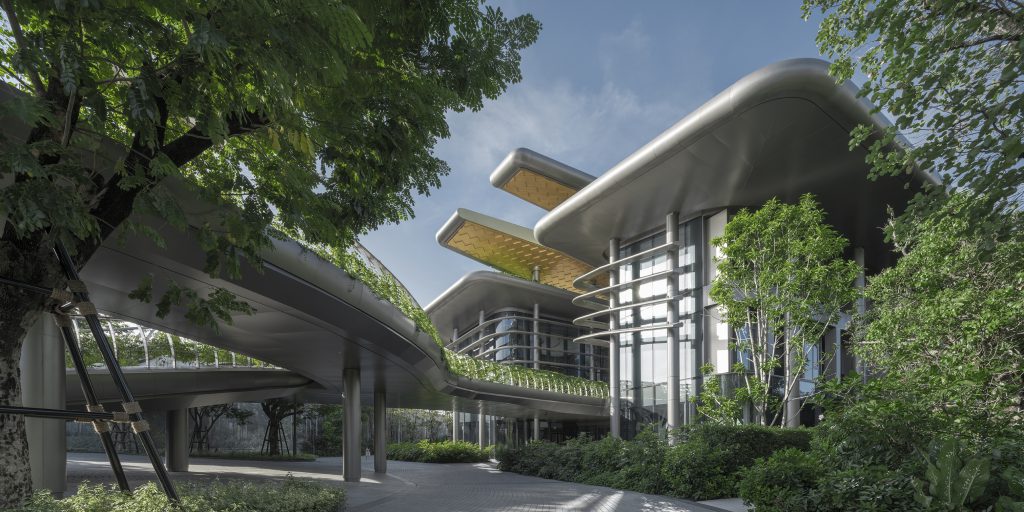
ภาษาสถาปัตยกรรมร่วมกันของอุษาคเนย์นั้นมีความโดดเด่นที่หลังคา เนื่องจากการใช้งานที่ต้องบังฝน แดด ให้ได้ตลอดปี จึงมีพัฒนาการเกี่ยวกับหลังคาที่ชัดกว่าส่วนอื่น เมื่อนำมาประยุกต์ใช้กับงานนี้ หลังคาจึงเป็นส่วนที่ให้ความสำคัญมากที่สุด หากสังเกตจากการอ่านอาคารโดยรวม ที่ออกแบบให้มีเส้นสายที่เชิดสูง แยกส่วนให้เน้นไปยังอาคาร แนวคิดนี้ส่งผลต่อการเลือกใช้สีทองที่ฝ้าชายคา เพื่อแสดงถึงความพิเศษในหลายวัฒนธรรม รวมทั้งสถาปัตยกรรมไทยด้วยเช่นกัน เมื่อเดินมายังพื้นที่กึ่งภายนอกภายใน สีทองของฝ้าจะเป็นทั้งตัวแสดงขอบเขตอาคาร การเลือกใช้พื้นผิวที่มีลักษณะเป็นคลื่นที่สถาปนิกชวนให้นึกถึงท้องหลังคาศาลาโถงแบบฝ้าเปลือย เผยให้เห็นด้านล่างของแผ่นเกล็ดมุงหลังคาแบบดินเผา
จากข้อจำกัดเรื่องระยะเวลาการก่อสร้าง การเลือกใช้โครงสร้างเหล็กเพื่อเพิ่มความโดดเด่นของหลังคา จึงดูจะเป็นทางเลือกที่เหมาะสมด้วยการยื่นออกไป 30 เมตร ทำให้หลังคาเป็นจุดรวมสายตา โอบรัดพื้นที่กิจกรรมในสวนด้านหลังให้เป็นพื้นที่เดียวกัน โครงสร้างหลังคาออกแบบโดยรีดศักยภาพของเหล็กมาใช้อย่างเต็มที่ ส่วนชายคาที่ยื่นออกไปยาว ถูกยึดด้วยโครงสร้างเสาตรงหน้าห้องทรงกระบอกซึ่งทำหน้าที่รับน้ำหนักมากที่สุดจากการรับแรงหลังคาที่ยื่นออกไปยาว ทำให้โครงสร้างหลังคาตรงเสาส่วนนี้รับมีความหนาที่สุดเพื่อรับแรงดัด

ส่วนปลายหลังคามีลักษณะเรียวลงตามน้ำหนักที่ลดลง รูปทรงหลังคาทุกอย่างเป็นไปตามแรงที่เกิดขึ้น โครงสร้างหลังคาส่วนบนถูกออกแบบเป็น space frame ถักกันเป็น super structure โดยแบ่งเป็น 3 ช่วง เพื่อสะดวกต่อการก่อสร้างให้สามารถยึดกับข้อต่อที่จุดยึดโครงสร้างหลังคา
เมื่อโครงการนี้แล้วเสร็จสมบูรณ์ จะกลายเป็นเมืองกลางป่าตามที่ผู้ออกแบบสาขาต่างๆ ของโครงการนี้ตั้งใจไว้ ให้อุณหภูมิโดยรอบจะต่ำกว่าที่อื่นในย่านเดียวกันที่มีพื้นที่ดาดแข็งมาก พร้อมกับการรอผลการสร้างพื้นที่ป่าขึ้นมาจากที่ดินเปล่า ที่มีผลตามมาทั้งสัตว์อย่าง กระรอก กวาง แมลง อย่างน้อยสิ่งที่สัมผัสได้จากวันที่ไปเยี่ยมชมงานนี้ในช่วงปลายฝนต้นหนาวของปี คือลมเหนือที่พัดผ่านมาด้วยอุณหภูมิที่เย็นสบายบริเวณโถงทางเดินตลอดวัน
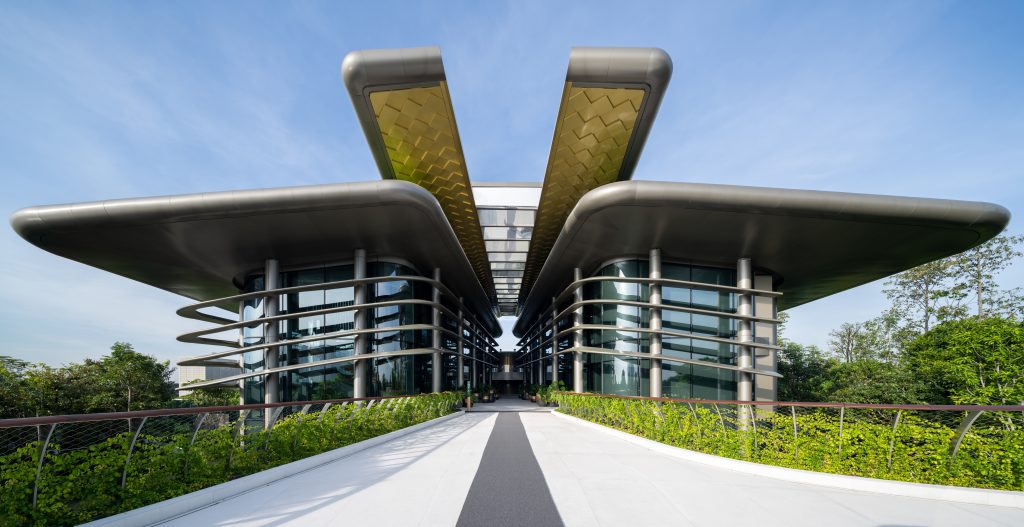
After its inauguration in 1851, Joseph Paxton’s Crystal Palace has become a monument which represents an architectural tale that embodies the genuine Modern Era and the materials that define it, be it steel or mirror. Since then, the architectural world has gradually shifted. Solid, bulky materials have been replaced by something lighter, but with the same or even more spatial and structural capacity. Steel structures have also seen a significant increase in use in modern Thailand due to its ability to deliver larger-scale projects in a shorter construction period, especially when compared to concrete structures.
A mega urban development was born in the expanding suburban economic area of Bangphli, Samut Prakan, bordering Bangkok’s Bangna district. The Forestia describes itself as a mixed-use development with a program that includes a housing estate, commercial spaces, a hospital, and hotels. Among the state-of-the-art shared amenities is the Forest Pavilion. With the architecture designed by F&P (Thailand) Company Limited, the pavilion is nestled in the lush Eco-Forest, a sharp contrast to the busy Bangna-Trat Road in front of the estate.
Pioneered by Professor Akira Miyawaki, the concept of Eco-Forests focuses on the production of small urban forests that mimic the ecosystem of natural forestlands where native plants are grown to increase biodiversity. With this method, the revival of urban spaces can take place ten times faster than with other techniques.
The functional program is separated into two wings: north and south. A corridor in the middle connects the two wings. A cylindrical-shaped chamber at the end of the pathway houses the project’s model. During the first phase, the North and South Wings are utilized to accommodate visitors to the project. In the future, the pavilion will be turned into a place for exhibits and a science museum, while the room where the model is shown will be converted into a café.
The spatial design is inspired by wall-less pavilions, which are a prevalent architectural feature in Southeast Asia. The design denotes the reception area and divides the program into three sections. The layout results in a walkway in the center of the program, which permits natural airflow throughout the day. The architecture also draws cooler air from the adjacent urban eco-forest into the functional spaces. The areas on the three floors are accessible via the central walkway, which leads visitors’ focus to the model room.

The symmetrical layout generated by the two wings and the skylight gives the impression that the roof is divided into two halves. The design directs guests’ attention to the far end of the roof, where the edge twists upward and protrudes 30 meters beyond the structure, linking the pavilion to the forest behind it. After a visitor walks through all of the spaces and reaches the end of the walkway, the design gradually shifts their view from the roof to the beautiful scenery of the urban forest.
Passive and sustainable design is the focal point of this project. The architect presents the concepts as the key element through the pavilion’s natural ventilation, which is achieved through the design of the floor, walls, and roof as independent components. It consequently increases the space around the pavilion’s perimeter, allowing natural airflow to reach all parts of the structure. The incorporation of natural light is made possible by the design of the roof, which consists of two distinct parts linked at the center by a skylight. With the assistance of ceiling-mounted reflective panels, excessive sunlight and heat are filtered out. These panels are engineered with triangular, three-dimensional characteristics that allow indirect sunlight to penetrate the surface. In order to create a more delicate lighting effect in the hallway, the light cast from the ceiling meets the surface on the side before dispersing.
In addition to the distinct line that runs around the structure and improves airflow, the roof covering the two wings of the building is designed to limit the amount of heat entering via the green roof. Solar photovoltaic cells are installed on the roof to produce solar energy for the project. Additionally, rainwater is collected from the roof and utilized within the pavilion. The cone-shaped roof’s broader side faces southward, allowing natural wind to
enter the building’s interior, particularly toward the central corridor. The panels fitted as eaves have zigzag profiles that limit wind interaction while retaining airflow inside the functional areas.
The air conditioning systems designed to lessen the noise and heat radiation that typical condensing units emit, becomes a nuisance for residents as a result. It is one of the intriguing aspects of the work. The solution proposed by the design team is the construction of the CUP (Central Utility Plant) as a separate facility located at the front of the project. The cool water from the CUP will be distributed through the underground pipes to reduce the temperature of the pipes buried under the concrete ground. The cooled water will be delivered back to the hospital and hotels for use in their laundry operations.
The distinctive roof structure is the architectural language that the architecture of Southeast Asia shares. With the primary purpose being to withstand rain and sunlight throughout the year, the roof is the architectural component with the most obvious evolution. The same story goes with this project, where the roof is one of the most prioritized components. By reading into the entire architectural structure, lines can be seen pointing upward and separated to accentuate the building’s presence. The concept was also influenced by the use of gold on the eaves’ ceiling, conveying the special characteristics derived from multiple cultures, including Thai architecture. Reaching the semi-outdoor area, the gold ceiling defines the building’s perimeter. The corrugated surface, on the other hand, looks like the exposed concrete ceiling of wall-less pavilions, revealing the bottom of the roof’s ceramic tiles.

Due to the limit of construction’s timing, the decision to employ a steel structure to make the roof more aesthetically unique has proven to be wise. The 30-meter projection makes the roof the primary focus, integrating the park’s activity zone in the back into a single coherent space. With the protruding eaves anchored to the columns at the front of the cylindrical room, the roof structure utilizes the full potential of steel.
Since the columns hold the majority of the weight from the cantilevered roof, the part of the roof structure that comes into contact with the columns is designed to be the thickest to bear the load of the flexural stress. As the weight is taken off, the roof becomes narrower, indicating how the roof structure is designed to respond to the increasing loads and pressures.
To ease the construction process, the upper portion of the roof is designed as a space frame, interwoven as a three-part superstructure. Each component is attached at the joints, which contribute to the structural integrity of the complete roof. When completed, the project will be transformed into the urban forest that the design team of professionals from various areas of practice had envisioned. The temperature in The Forestia will be relatively lower than its neighboring areas, which consist primarily of hard surfaces. The urban forest will grow to become a home for creatures such as squirrels, deer, and insects. At the time of this visit, the rainy season was drawing to an end before the approach of winter. The chilly air from the north could be felt as it circulated along the corridor.
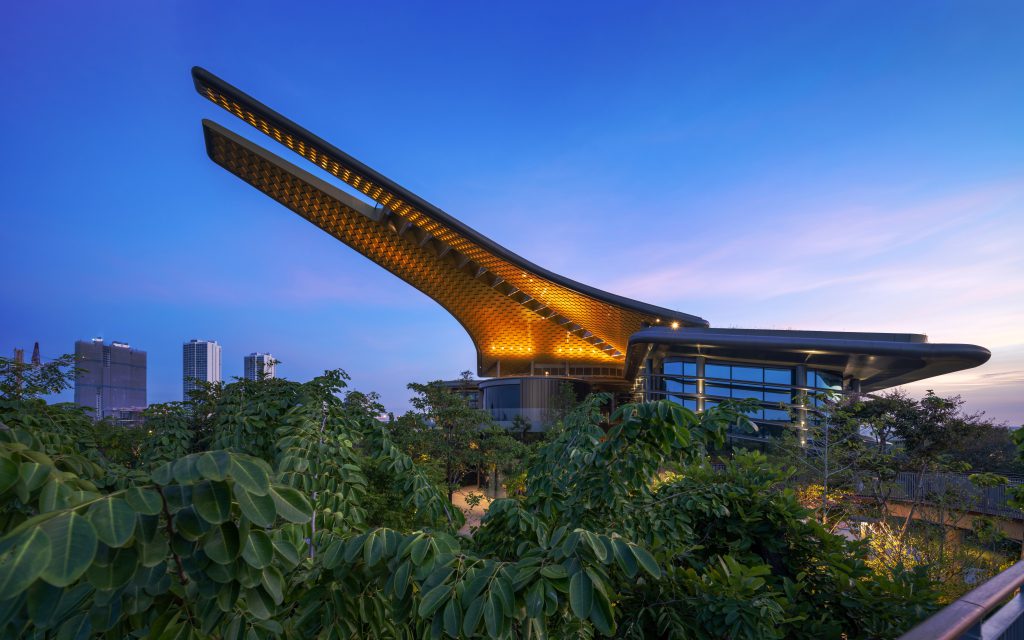
อ่านบทความคอลัมน์อื่นๆ หรือดาวน์โหลดเล่มวารสารฉบับออนไลน์ 09 Metal Attraction คลิกได้ที่นี่


